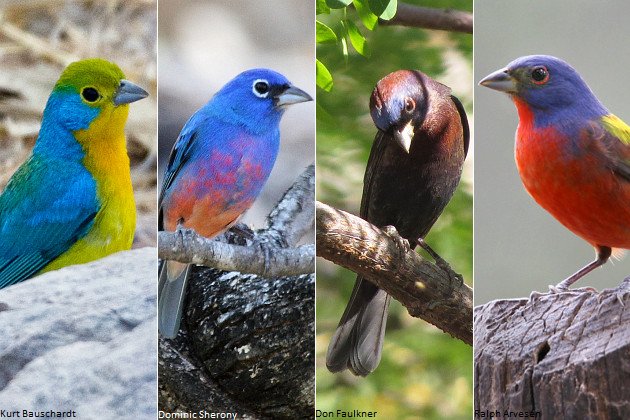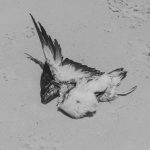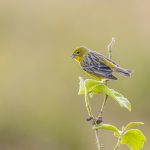
Everyone, the Painted Bunting needs your help. There’s a new proposal before the American Ornithologists’ Union’s North American Classification Committee to split Painted Bunting into two species (yay! — maybe, more later) and to name the new species “Eastern Painted Bunting” and “Western Painted Bunting” (no!). And given the AOU’s hyphenation policy, it’s not hard to imagine that “Eastern Painted-Bunting” and “Western Painted-Bunting” might also be considered. Did you just choke on your coffee? Good, because I think the situation is obscene. (Photo: Andy Morffew)
So clutch your pearls if you must, academics, because somebody’s got to wave a flag for wonder and decency in the world, and today that fool’s going to be me.
First, a little background.

(l-r) Orange-breasted Bunting (Passerina leclancherii), Rose-bellied Bunting (P. rositae), Varied Bunting (P. versicolor), Painted Bunting (P. ciris)
The Painted Bunting, Passerina ciris, belongs to a genus of beautiful blue cardinals that also includes the Blue Grosbeak and the Indigo Bunting. But the Painted Bunting and its three closest relatives within Passerina (pictured above) also mix and match red, orange, and yellow pigments with their blue structural colors to spectacular effect.
Here’s what we knew about the Painted Bunting up until about 2010:
1. There are two Painted Bunting populations, one that breeds along the Atlantic Coast from North Carolina to Florida and one that breeds in the interior United States and northern Mexico from southeastern New Mexico to western Mississippi. For reasons no one fully understands, much of Mississippi, Alabama, and inland Georgia lack Painted Buntings during the breeding season, a gap of several hundred miles. You can see the two disjunct populations mapped in this animated occurrence model from eBird.
2. The Atlantic Coast population lingers on the breeding grounds after nesting to molt. The interior population migrates after nesting to stopover areas in Mexico and Arizona, molts, and then continues on to its wintering grounds. Eastern birds are thought to winter in Florida and the Caribbean; western birds, in Mexico and Central America, but winter distributions are not yet fully understood.
These two points are discussed thoroughly in Tom Schulenberg’s 2009 account for Neotropical Birds Online: Painted Bunting: Distribution.
So, what have we learned since 2010, and why is a Painted Bunting split up for discussion now?

Photo by Andy Morffew
In 2011, Connie Herr completed a dissertation and a peer-reviewed paper on the first genetic study of Painted Bunting diversity across its range, using mitochondrial DNA. Genetic divergence between the eastern (coastal) and western populations had been hypothesized but not tested until her study. Sure enough, the study found that “significant genetic structuring is apparent between the allopatric Atlantic Coast and interior breeding populations of the Painted Bunting” and that “Painted Buntings are genetically partitioned into interior and coastal populations.”
Herr describes the two populations as “incipient species” that “should be recognized as separate management units” from a conservation perspective.
With genetic data now in hand, Robert C. Tweit formally proposed that the AOU split the Painted Bunting into two species.
We’ll know next July whether the AOU thinks there’s sufficient justification to accept the split. It’s certainly an interesting situation — most recent passerine splits have had to try to argue that hybrid zones aren’t necessarily an indicator of widespread gene flow; in this case, there’s a geographic gap hundreds of miles wide between the populations.
And now I climb up on my soapbox: What if we didn’t call the new species Eastern and Western anything (hyphenated or otherwise) if the split passes? What if we chose new English names for both species, names that capture the wonder and appreciation that these birds inspire in us humans? Why should the birds be saddled with horrendously boring adjectives like “eastern” or sullied by humorless battles over hyphenation?
Stability, stability! I hear the cries. “Proposals to modify English names are nearly always contentious and involve weighing competing factors to determine whether the changes proposed improve accuracy and clarity sufficiently to outweigh the cost of the instability they would cause,” says the AOU. Using “Eastern Painted(-)Bunting” and “Western Painted(-)Bunting” would serve to maintain a connection to the last 150 years or so of ornithological and popular literature, but wouldn’t it also barricade one (or rather, two) of our most charismatic and awe-inspiring songbirds behind the bars of pedantry and elitism? How do we capture the joy, the excitement, even the devotion and sense of identity that are needed to inspire conservation? By using names that match our feelings, that’s how.
Here are some ideas:
- Rainbow Bunting
- Magnificent Bunting
- Many-colored Bunting
- Jewel-like Bunting
- Scrub-gem Bunting
- Brilliant Bunting
- Bling Bunting
- Resplendent Bunting
- Tye-dye Bunting
- Legendary Bunting
- Marvelous Bunting
- Fly Bunting
- Gorgeous Bunting
Go ahead, tell me all the reasons this is silly — or better yet, dream up some names of your own and submit a formal proposal to the AOU. Keep wonder alive!










Agreed, with whole heart: the two need their own names.
How about
Nonpareil Bunting
for the eastern bird, and
Seven-colored Bunting
for the western bird.
“Nonpareil,” of course, was in use for a long time in the US, and “seven-colored” simply translates the Spanish name, entirely appropriate for a bird most of whose population breeds in Mexico. That solution would leave us with “Painted Bunting” for the complex.
Failing that, I’d go for Pope for the western birds and Patriarch for the eastern. Not much chance of that, though.
If one of these doesn’t get named Parton’s Bunting in acknowledgment of its coat of many colours I’ll be most depressed.
Rick — I like the idea of translating sietecolores!
TH — You win all the things.
I agree. The same thing happened with the Blue Tit, which thanks to a split became the Eurasian Blue Tit. Stupid stupid stupid.
Of course, the whole point is moot, cause that ain’t a bunting. It’s a cardinal/tanager/whetever. So call one a Painted Rainbowbird and the other the Splendid Rainbowbird.
This post explains why scientists should be English majors. Or maybe the other way around. 🙂
If it is going to be named after a coat, it should be Joseph’s.
These thoughts are too high for me, but I might just go peruse all my back yard photos of these beauties that visit my feeders all summer long.
Awesome post and contributions. I agree with Rick that Seven-colored suits the Western race. I also like some of the FB and twitter suggestions like Resplendent. We just need more Resplendent birds in the world.
I like “Nonpareil” for the eastern species, for the reason Rick gives.
Rick is right with his suggestion of nonpareil bunting. Many people here in the South Carolina Lowcountry still call it that.
Hehe, excellent stuff! Bling Bunting would be awesome.
However, if this split passes, I will eat my Tilley hat. Given the committee’s past rejections of MUCH better potential splits, I’d wager that there’s a 0.01% chance of acceptance of the PABU split.
How about Splendid Bunting and Superb Bunting? Which is which? Randomize, that’s how nature does it!
Why even call it a bunting when it isn’t one?
Seven-colored Bunting sounds too much like one of my favorite Chinese food dishes: Seven-flavor Beef. Makes me squirm to think of eating such a beautiful (and no doubt bony) little bird.
Perhaps a geographic term a bit more exciting than “Eastern” or “Western” would work. Pecos Bunting? Borderland Bunting? Dixieland Bunting?
Better watch out for Nonpareil. People may think it’s OK to trap them again.
I’m so happy that Connie Herr knows that the two Painted Bunting populations are incipient species. Does she have a really good crystal ball, or has she been appointed a god?
Uh, the two populations *are* incipient species. They are geographically and genetically isolated at the moment, which puts them on the path to speciation. Thus, incipient species. This is very different from calling them taxonomic species, which is what the proposal is advocating. Also, Dr. Herr is not the one advocating this split. In her paper, she only suggests that the two populations be treated as separate management units (AKA Evolutionarily Significant Units), not separate species. Robert Tweit is the one that submitted the proposal.